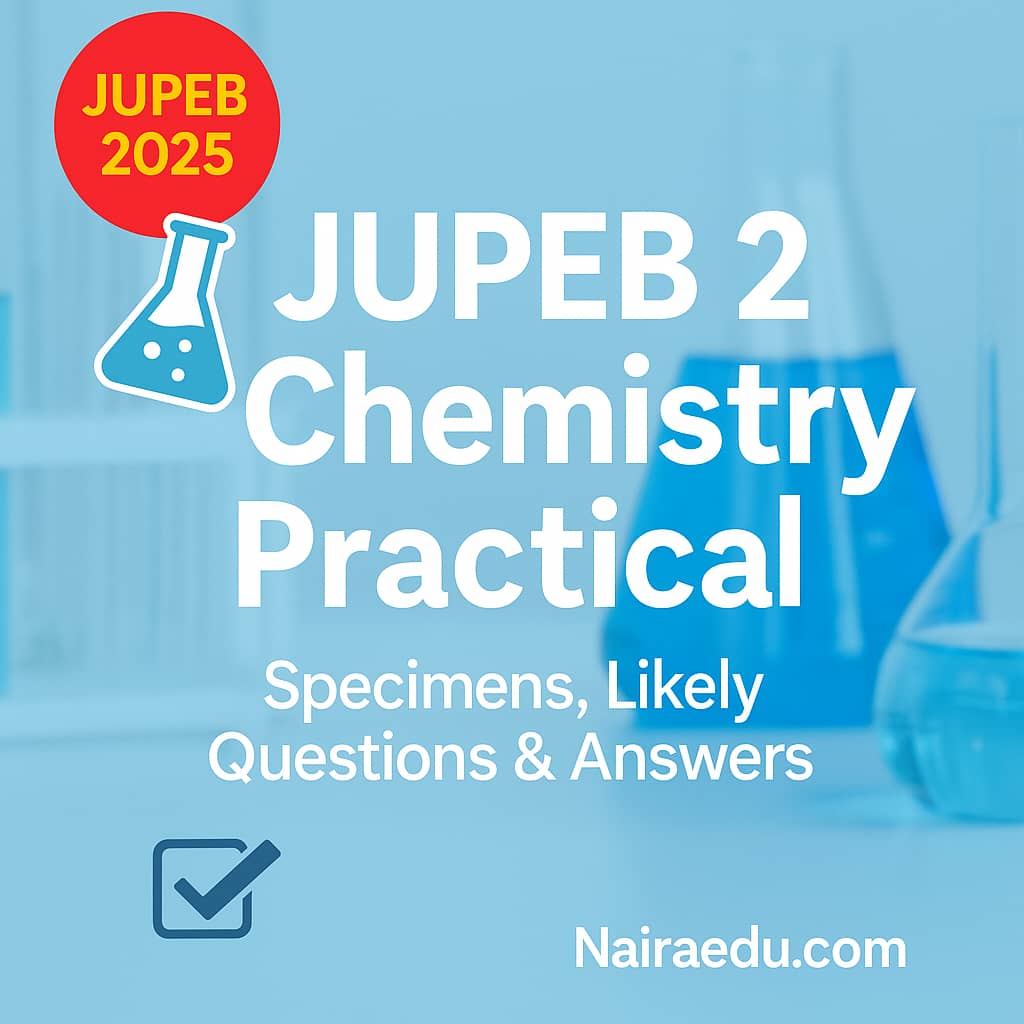Are you preparing for the JUPEB Chemistry Practical 2025? This article on Nairaedu.com is carefully written to guide you with everything you need to know about the practical exam. The JUPEB (Joint Universities Preliminary Examinations Board) practical in Chemistry is a compulsory part of the exam that tests your understanding of real life chemistry experiments.
In the 2025 exam, students will be expected to work with acids, bases, salts, and laboratory equipment. Knowing the specimens ahead of time helps you prepare better and avoid surprises in the exam hall.
This blog post contains the full list of practical specimens, expert explanations, and helpful tips to make sure you pass with flying colours.
JUPEB Chemistry Practical 2025 Specimens
Below is the full list of specimens released for the JUPEB Chemistry Practical 2025.
| S/N | Specimen | Description |
|---|---|---|
| 1 | A | Acetic acid – 1.5 g in 250 mL of solution |
| 2 | B | Sodium hydroxide – 4 g of NaOH in 1000 mL of solution |
| 3 | X | Hydrated Copper sulphate – CuSO₄·nH₂O |
| 4 | Y | Zinc dust |
| 5 | Z | Ferrous sulphate – FeSO₄·7H₂O |
| 6 | – | Phenolphthalein Indicator |
| 7 | – | Burette (50 mL) |
| 8 | – | Pipette (25 mL) |
| 9 | – | Three 250 mL Conical Flasks |
| 10 | – | 250 mL Beaker |
| 11 | – | X and Y – Two Inorganic Salts |
| 12 | – | Spatula |
| 13 | – | Bunsen Burner |
| 14 | – | Boiling Tube |
| 15 | – | 2M NaOH |
| 16 | – | 2M HCl |
| 17 | – | Ammonia Solution (NH₄OH) |
| 18 | – | Bench solution of BaCl₂ |
| 19 | – | Four (4) Test Tubes |
These chemicals and tools will be used to test your knowledge of titration, qualitative analysis, and observation based reactions. You will also be required to write balanced chemical equations and make accurate inferences from your experiments.
Breakdown of Each Chemical Specimen and Their Use
Understanding each chemical specimen helps you perform confidently during your JUPEB practical. Below is a breakdown of the major chemicals and equipment, along with how they are used in the exam.
Acetic Acid (Specimen A)
Acetic acid is a weak organic acid commonly used in titration. In the exam, it might be used as the acid solution in an acid-base titration to determine its concentration using NaOH and an indicator like phenolphthalein.
Sodium Hydroxide – NaOH (Specimen B)
NaOH is a strong base. It reacts with acids in neutralization reactions. You’ll likely use this with acetic acid for titration. Remember to fill the burette with NaOH and use a pipette for the acid.
Hydrated Copper(II) Sulphate – CuSO₄·nH₂O (Specimen X)
This blue crystalline salt is often used in qualitative analysis. When heated, it loses water and turns white. When water is added again, it returns to blue. This shows reversible hydration – an important practical concept.
Zinc Dust (Specimen Y)
Zinc is a reducing agent. It can displace less reactive metals from their salt solutions. You may be asked to mix it with copper sulphate and observe displacement reactions and colour changes.
Ferrous Sulphate – FeSO₄·7H₂O (Specimen Z)
This green salt is sensitive to oxidation. It may be used to test for oxidation reactions or mixed with other reagents to identify iron ions (Fe²⁺).
Phenolphthalein Indicator
This is a colourless compound in acid but turns pink in base. In titration, it helps you know the end-point when the pink colour first appears.
Glassware: Burette, Pipette, Conical Flask
- These tools are essential in titration experiments. Make sure you:
- Rinse each with the correct solution before using.
- Read measurements at eye level to avoid parallax errors.
Bunsen Burner & Test Tubes
Used to heat chemicals like copper sulphate or for flame tests. Always wear goggles and tie back loose clothing when working with fire.
Likely Questions and How to Answer Them
Here are possible question types and how to structure your answers in the exam.
Titration Question Example
You are provided with a solution of acetic acid and NaOH. Using phenolphthalein as indicator, carry out a titration to determine the concentration of the acid.
What to Do:
- Fill the burette with NaOH and the pipette with acetic acid.
- Add 2–3 drops of phenolphthalein to the conical flask.
- Titrate until the solution turns light pink and record the reading.
- Repeat to get concordant values.
How to Report:
- Record your burette readings (initial, final, volume delivered).
- Show your calculation:
C₁V₁ = C₂V₂
Qualitative Salt Analysis
Identify the anions and cations in specimen X and Y.
How to Answer:
- Record colour, smell, reaction with NaOH or NH₄OH.
- Add drops of reagents like BaCl₂ or HCl.
- State what you observed and the inference you made.
E.g., A white precipitate soluble in excess NH₄OH indicates Zn²⁺.
Observation and Inference Table
| Test | Observation | Inference |
|---|---|---|
| Add a few drops of NaOH to Solution A | White precipitate formed, soluble in excess | Al³⁺ may be present |
| Add HCl to Solution B | Effervescence observed; colorless gas evolved | CO₃²⁻ ions likely present |
| Add AgNO₃ to Solution C | White precipitate formed, darkens on standing | Chloride ion (Cl⁻) confirmed |
| Add BaCl₂ to Solution D followed by dilute HCl | White precipitate formed, insoluble in HCl | Sulphate ion (SO₄²⁻) present |
| Heat solid E in a dry test tube | Colorless gas evolved turns limewater milky | Carbonate compound present |
Smart Tips to Score High in JUPEB Chemistry Practical
Scoring high in JUPEB Chemistry Practical is not just about cramming—it’s about strategy. Below are proven tips that can help you ace the practical:
1. Master Titration Techniques
- Always rinse your burette and pipette with the exact solution you are going to use.
- Ensure there are no air bubbles in the nozzle of your burette.
- Read from the bottom of the meniscus at eye level.
- Always record initial and final readings in every trial.
- Aim for concordant values—readings within ±0.1 cm³ of each other.
2. Be Neat and Systematic
- Use a clean white tile or paper beneath test tubes to observe color changes better.
- Label test tubes, conical flasks, and beakers clearly.
- Use clean cloth or tissue to wipe spills quickly—examiner impressions matter.
3. Know Your Observation and Inference Table
- Practice how to record observations with simple, clear words.
- Learn common reactions and how to link them to specific ions or compounds.
4. Prepare Your Calculations
- Practice mole calculations and titration formulas before the exam.
- Always show full working steps clearly even if your answer is wrong, marks are awarded for steps too!
5. Avoid These Mistakes
- Don’t add excess indicators.
- Don’t rush, read instructions fully.
- Avoid erasing results on your data sheet, cancel neatly and rewrite.
ALSO READ:
JUPEB Biology Practical Specimens 2025 and Likely Questions with Answers
JUPEB Yoruba Questions And Answers 2025
2025 JUPEB Igbo Questions And Answers
JUPEB Igbo Questions And Answers 2025
2025 JUPEB Examination Timetable
Conclusion
The JUPEB Chemistry Practical 2025 exam is your chance to prove your lab skills and secure good grades. With the specimen list provided and smart preparation strategies, you are already ahead of many. Remember, your success depends not just on what you know, but how well you apply it during the exam.
We at Nairaedu.com are dedicated to helping Nigerian students like you prepare better, smarter, and pass with flying colors. Bookmark this page and keep revising!

Mr. Femi is an education blogger who simplifies exam updates and study tips for Nigerian students. His goal is to make learning smart, easy, and rewarding.

